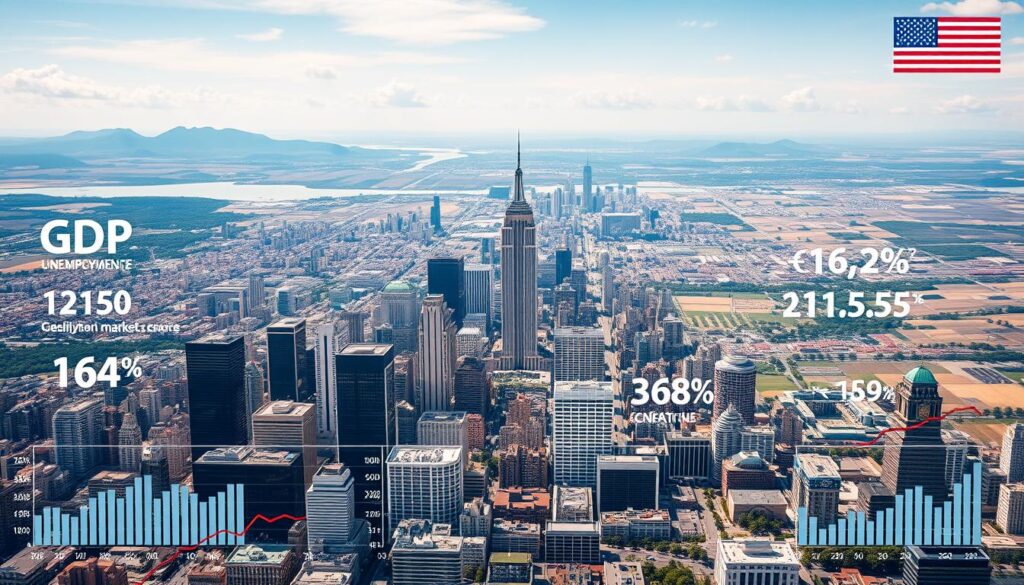The US economic sector is crucial for both national and global markets. It’s always changing. This analysis looks into how different sectors grow and what trends impact the economy. We look at important indicators to understand the forces shaping the economy now and what might happen next. By focusing on accurate data, we aim to show how these economic changes affect businesses and our daily lives.
Overview of the US Economy
The US economy is complicated to understand. There are changes happening that affect us and the world. Experts focus on the GDP and other important trends to figure out the economy’s health.
Anúncios
Current Economic Landscape
In the first quarter of 2025, the US saw its real GDP go down by 0.5%. This happened because we bought more from other countries and the government spent less money, after a 2.4% growth in the last quarter of 2024. The deficit in our current account grew to $450.2 billion or 6.0% of the GDP. This shows the challenges we face in trade and adjustments we have to make in our economy. These changes are important to watch for future growth and stability.

Role of Major Economic Indicators
Big economic signs show how healthy the US economy is and where it’s heading. Things like GDP trends, how many people have jobs, personal incomes, and how much people are buying tell us about the economy’s condition. For example, personal income went down by $109.6 billion or 0.4% in May 2025. This affects how much money people have to spend. Understanding these factors helps us see how the economy is doing now and what might happen next.
The Importance of Economic Sectors
The economy is like a big machine made up of different parts. Each part, or sector, is important for the whole system to work well. Knowing about these sectors helps us understand how our economy grows.
There are three main types of sectors: primary, secondary, and tertiary. Each one adds something special to our economy, helping it to grow and thrive.
Defining Economic Sectors
The economy is split into groups like agriculture, manufacturing, and services. This split helps us see how each part is doing. It also shows us their roles in making our economy stronger.
By studying these sectors, experts can find out what’s working well and what needs improvement. This knowledge helps in making smart decisions for our country’s future.
How Economic Sectors Contribute to Growth
These sectors help our economy by bringing new ideas, making us more efficient, and creating jobs. When sectors grow, people spend more and invest more. This makes our economy even stronger.
Trade has helped Americans earn more since WWII, boosting incomes by 9%. This fact highlights how crucial these sectors are. They are key to long-lasting economic health.
Consumer Spending Trends
Understanding consumer spending trends gives vital insights into the economy. Recent data points to shifts in how people spend, with inflation playing a big role. These shifts impact buying power and how much people spend overall.
Recent Changes in Consumer Behavior
Recent reports show slower growth in spending, with a 1.2% increase in Q1 2025. This is way less than the previous 4% growth. Consumers are changing how they spend their money. They are also feeling less confident because they expect inflation to rise. This lack of confidence changes how and on what they spend.
Impact of Inflation on Spending
Inflation is making it harder for people to buy what they need. Especially for long-lasting goods, growth has slowed down. Facing higher prices and changes in policy, people are cautious about future spending. This situation affects spendings trends, forcing both shoppers and retailers to change.
Business Investment and Its Implications
Business investment is vital for the economy’s health. It shows how industries think about their future growth. In early 2025, equipment investment jumped by 24.7%.
This increase happened as businesses bought more equipment, fearing new tariffs. Such moves show they believe in future growth, despite facing big challenges.
Investment Patterns Across Different Industries
Investment is key to economic growth across sectors. The tech, manufacturing, and healthcare sectors are often ahead, focusing on being modern and efficient. Their spending patterns respond to market needs and new tech.
The jump in equipment investment underlines the need to stay ahead. Even so, navigating this landscape is hard.
Challenges Affecting Business Investments
The economic uncertainty creates hurdles for investment. Especially small businesses feel less confident, impacting their spending plans. High interest and tariffs make investors wary.
These issues might lead to less spending on buildings and machines. Tackling these challenges is crucial for strong business investment in the future.
Understanding the Labor Market
The US labor market is complex. It has different employment rates and job growth trends across sectors. Economic changes and business decisions impact these trends. It’s important to understand these aspects for analyzing the workforce now and in the future.
Employment Rates and Trends
By 2025, the US labor market faces challenges. The unemployment rate is expected to rise. This is due to slower business investments and changes in hiring. Tariffs also play a role, affecting how many people work. Watching how economic policies affect jobs is crucial.
Sector-Specific Job Growth
Jobs in different sectors are growing unequally. Some industries grow fast because demand is high. Others struggle due to economic issues and big changes. Knowing these differences helps figure out which sectors will do well or poorly. It shows the need for specific workforce plans for different areas.
Foreign Trade and Its Impact on Economic Sector Dynamics
Foreign trade greatly shapes the United States’ economy. It shows how well the country is doing financially. In May 2025, a big increase in trade deficits was seen. This happened because we exported less and imported more. This situation needs close attention.
Trade Deficits and Surpluses
Having more imports than exports can slow down economic growth. It makes the country depend too much on foreign products. Especially, the manufacturing and farming industries feel this the most. It’s important to think about whether we can keep this up and still grow.
Effect of Tariffs on Trade
Tariffs play a big role in trade. Changes in tariff rates have major effects on global trade and prices here at home. This makes it harder for exporters and challenges the trade balance. Policymakers need to find the right mix between protecting businesses and staying competitive globally.
The Role of Government Spending
Looking into how the government spends money shows its big role in growing the economy. It invests in important areas like infrastructure, education, healthcare, and welfare. These investments lay the groundwork for economic growth.
This spending boosts confidence and creates jobs. Both are key to a strong economy.
Impact on Economic Growth
Government spending and economic growth are closely linked. Money is put into important areas such as:
- Infrastructure projects that improve transport and connections.
- Public services that help communities grow and improve life quality.
- Safety nets that keep things stable when the economy shakes.
Changing where the government spends money can kickstart new industries. Or it can make existing ones stronger. This points to a bright future of sustainable growth.
Federal and State Spending Trends
Federal spending trends show a tricky situation, with less money coming in from taxes and changing economy. By 2025, these changes might influence how government budgets work. Here are some key points:
- There will be a bigger effort to keep the economy stable, despite ups and downs.
- Different states will spend based on what their local economies need and face.
- Funds might be moved to sectors like healthcare and education, where they’re needed most.
Current Challenges Facing the US Economic Sectors
The US economy is facing tough times with several big problems. These include the impact of rising prices and changing interest rates. They affect everyone, from individual shoppers to big companies in many areas. It’s important to understand these issues to know how the economy is doing.
Inflation and Interest Rate Effects
Inflation is making it harder for people to buy what they need. This is because the cost of everyday items is going up. Families find it hard to spend as much as they used to. At the same time, interest rates have gone up to fight inflation. This makes loans and mortgages more expensive. As a result, companies are cutting back on spending, which slows down the economy.
Global Economic Influences
The US economy is affected by what happens around the world. Things like international deals, political tensions, and market changes elsewhere can impact us. For example, problems with getting goods or changes in trade rules can make our own issues worse. Because of how connected we are globally, events in other countries can quickly affect American businesses and shoppers.
Future Prospects for the US Economic Sector
The US economy is changing. Many things influence what will happen next. One key factor is predicting Gross Domestic Product (GDP) growth correctly. Forecasts show a careful attitude, mostly because of different local and world issues. Things like high tariffs, changes in what people buy, and uncertain global markets might make the economy slow. Estimates say growth could be around 1.4% by 2025.
Forecasting GDP Growth
Experts say it’s important to know what affects GDP growth predictions. Many signs point to people being wary about investing or spending. This carefulness could change how money is used and impact economic growth.
Emerging Trends to Watch For
New trends provide hints about where things might be going. Technology improvements, changes in policies, and updates in worldwide trade deals are key areas to watch. Companies will likely invest in areas that make them more efficient. They aim to find new chances while navigating these changes.
Conclusion
When we look at the US economy today, we see how important it is to understand different economic parts. Each sector adds its own touch to our growth and affects others too. This shows why making smart policies that keep things stable and encourage investments is key.
Talking about the economy, we see how spending by people, businesses, and the government shapes things. We need to watch these areas closely because they show us big trends and challenges. In the future, dealing with inflation, interest rates, and how global issues affect us will be crucial.
Even though we face challenges, there are also many chances to grow and innovate. If we act early and wisely, we can make the most of new opportunities. It’s very important to keep an eye on economic signs to build a strong future for the US economy.
FAQ
What were the key factors influencing the US economic landscape in Q1 2025?
How do major economic indicators affect consumer behavior?
What are the different economic sectors and their roles?
How has consumer behavior changed recently?
How is inflation impacting consumer spending?
What are the current trends in business investment?
What challenges are small businesses facing regarding investments?
What is the status of employment rates in the US?
How do trade deficits affect the US economy?
What is the impact of tariffs on trade and economic sectors?
How does government spending influence economic growth?
What fiscal challenges do governments face in 2025?
What challenges does inflation and high interest rate pose?
How do global factors influence the US economy?
What are the GDP growth forecasts for the near future?
What emerging trends should be watched for in the US economy?
Conteúdo criado com auxílio de Inteligência Artificial



